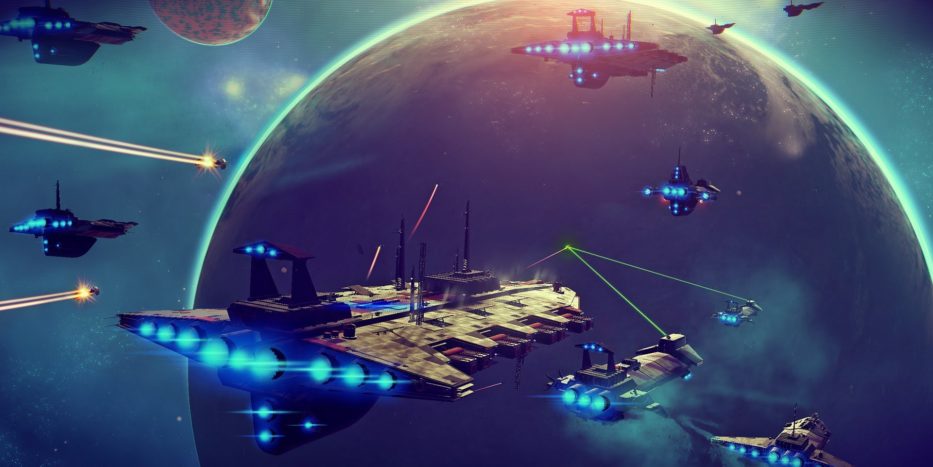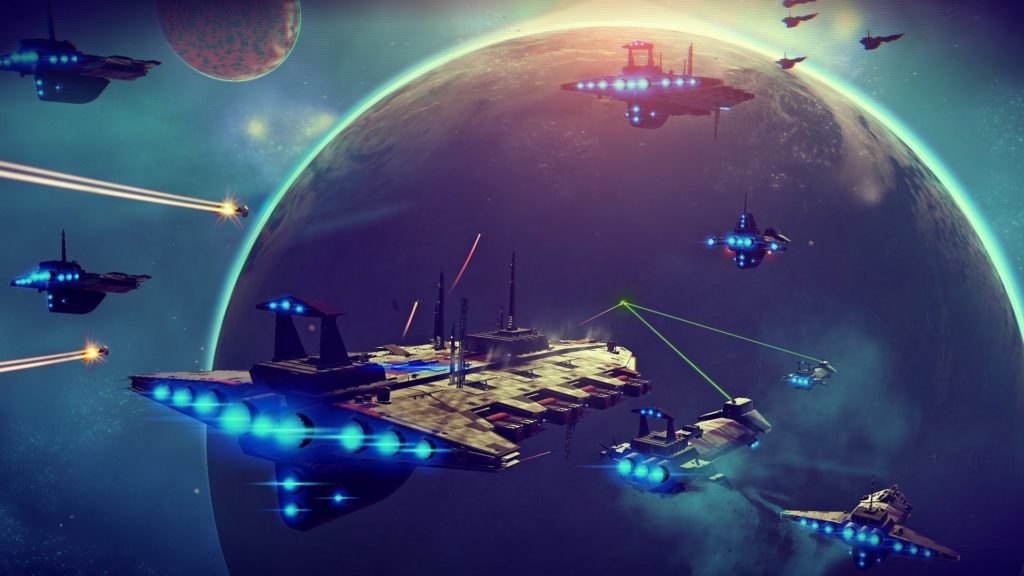I want to start off by saying I was never fully aboard the No Man’s Sky space shuttle to Hype-opolis Prime. I would meet up with it occasionally at the launch pad and tentatively poke my toe in the door before hopping back out.
There may have been a point close to release where I’d nearly strapped myself in for blast off, but, after Hello Game’s day one patch note changes turn out less dramatic than expected, I ran for the exit. Hype had no hold on me when I began my galactic adventures.
No Man’s Sky has a strong “honeymoon” phase, it gives you a literal universe of possibilities and the player can’t help but drool over the idea of what might be out there. You scour your starting planet mining, scavenging, scanning, and naming everything you can get your desperate spaceman hands on. If you have the (mis)fortune of being granted a deadly planet to begin on, it makes the challenge of repairing your ship all the sweeter.
Unfortunately, that starting point is the peak of challenge in NMS. It never returns to the glorious moment of scrambling across a planet that’s trying to kill you, without the aid of a spaceship to keep you safe. Once your ship is functional, landing directly next to anything you want to investigate and running back to recharge your systems becomes par for the course and trivializes the entire experience. There’s no reason not to do it, as ship fuel is something you’ll be constantly tripping over. Seriously, it’s everywhere.
From an objective standpoint, the only true goals in NMS are the maximization of your inventory space to store more goodies, and collecting all the blueprints that make your life a little easier. Neither of these tasks take terribly long as most players will quickly recognize the patterns behind them. They’ll know exactly what to seek out to get the things they’re looking for, causing gameplay to become mechanical quickly.
Conversely, there are a few features that the game fails to mention at all and some players might miss them entirely. Installing upgrades in specific locations is one of them. Players will notice that upgrades come in tiers, such as sigma/tau/theta/omega, but they aren’t informed whether they need all of them or if only the strongest upgrade takes priority. The answer is that they all stack, but they also gain a highlighted multiplier bonus if they’re built adjacent to each other. Even the default systems, the basic mining beam for example, is included in the grouping. Entire groups of the same type of upgrade can be built adjacent as well for even more bonus power. A multi-tool with only well ordered mining upgrades becomes hugely powerful as all the grouped upgrades will be boosting every other upgrade.
Another of these strangely unexplained features are the warp drive upgrades. Each tier actually allows access to new types of star systems. If you look closely at the star map, you can see that the stars are different colors. Yellow are the basic systems, but pink ones are sigma level, green is tau, and blue is theta. Higher tier stars seem to have more and stranger anomalies hidden within them to discover.
Personally, my favorite activity in NMS is the collection of languages. The real story of the game lies within the history of the alien races and they mysterious words of Atlas. The Atlas language is particularly difficult to build up to any large degree, since the words only come from completing the somewhat rare monolith text puzzles. The plaques you find not only teach you further words, but they all give the player a small piece of alien history. Perhaps one day I’ll have learned enough to understand what the heck is going on behind the scenes.
That is, if it can hold my interest long enough. While No Man’s Sky is technically an infinite game, there’s really not a whole lot to do. Or, rather, not much to do beyond what the player has already experienced many times before. It’s an exercise in repetition. Having binged the game for a few days, I find that I’m already running out of new things to find. I’m only missing a handful of blueprints, I have more inventory space than I know what to do with, and my knowledge of languages (aside from Atlas) is fairly complete. The alien races never do anything new, or even move. You see the same assets over and over again. Even the majority of the planets start to look the same, only with differing color schemes. The pitfalls of procedural generation are here in force.
It’s hard to nail down exactly what the long term appeal of NMS is. I’ve looked into the Atlas and Center endings, and to call them endings is a bit of an insult to endings in any other game. If you’re making a beeline for either of these conclusions, there’s a strong chance of disappointment in your immediate future. It takes a while to realize it, but no destination has the answers you’re seeking. The real core of the galaxy is you.
NMS is at its best when you ignore all the silly things the game is trying to tell you to do and wander aimlessly across the stars in search of exceptions to the sea sameness. It shines when you find that one planet that breaks the mold or that one creature that makes your eyes go wide. It kickstarts your imagination, inspires you to dream up stories and sensible names for your discoveries. Then, with the knowledge that someday someone might also find what gave you joy, you soar off deeper into the unknown. You are a leaf on the wind.
Just be a sensible leaf who waits for a sale.





